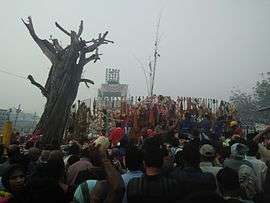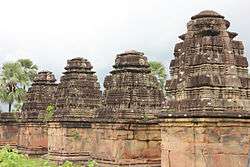Sammakka Saralamma Jatara
Sammakka Saralamma Jatara (also Sammakka Sarakka Jatara and Medaram Jatara)[1] is a festival to honour the Hindu tribal goddesses, celebrated in the state of Telangana, India. This Jatara is known for witnessing one of the largest people gatherings in the world. People offer Bangaram (jaggery) :The Jatara begins at Medaram in Tadvai mandal in Mulug district. The rituals related to the Goddesses are entirely conducted by Koya tribe priests, in accordance with Koya customs and traditions.
| Sammakka Saralamma Jatara | |
|---|---|
 | |
| Also called |
|
| Observed by | tribes |
| Observances | Offering to the Goddess |
| Frequency | every 2 years |
Until 1955, about 2,000 people used to visit Medaram, of which the majority 1,500 belonging to the Koya tribe.But now a large number of non-Koya people(1.3 crore) visits Medaram and the Koya people comprises only 2% of the total worshippers.[2]
Medaram is a remote place in the Eturnagaram Wildlife Sanctuary, a part of Dandakaranya, the largest surviving forest belt in the Deccan.
Once declare a national festival, jatara can be considered for 'intangible cultural heritage of humanity' tag of UNESCO. Jatara celebrated during the time the goddesses of the tribals are believed to visit them. It is believed that after Kumbha Mela, the Medaram jatara attracts the largest number of devotees in the country.
History
It commemorates the fight of a mother and daughter," Sammakka and Saralamma" (also known as Sarakka), with the reigning rulers against an unjust law. Game There are many legends about the miraculous powers of Sammakka. According to a tribal story, about 6-7 centuries ago, that is in the 13th century, some tribal leaders who went for a hunting found a new born girl (Sammakka) emitting enormous light playing amidst tigers. She was taken to their habitation, and the head of the tribe adopted her and brought up as a chief. She later became the saviour of the tribals of the region. She was married to Pagididda Raju, a feudatory tribal chief of [Kakatiyas] (who ruled the country of Telugus from Warangal City between 1000 AD and 1380 AD). She was blessed with 2 daughters and one son namely Sarakka, Nagulamma and Jampanna respectively. Jampanna died in this attack and fell bleeding into a vaagu (stream) and later the whole sampangi vaagu has turned red due to which it was later on called JAMPANNA VAAGU near the place where the present mela is taking place.
Ritual
.jpg)
Sammakka Saralamma Jatara is a tribal Hindu festival, held at about 100km from Warangal city. It is the time for the largest tribal congregation in the world, held every two years (biennial), with approximately ten million people converging on the place, over a period of four days. Many devotees from different states of India (Andra Pradesh, Telangana, Madhya Pradesh, Chhattisgarh, Orissa, Maharashtra, Karnataka and parts of Jharkhand) reach to the festive place to celebrate the Jatara.
People offer bellam (jaggery) to their weight to the goddesses and take holy bath in Jampanna Vagu (stream).
In 2008, nearly 8 million people were estimated to have attended the festival. And in 2012, the gatherings in the jatara are roughly estimated to be 10 million. This fair is said to be the largest repeating congregation of tribal communities in the world. It is also one of the largest Hindu gatherings in the world.
This Festival held in 2016 is the first one after the formation of Telangana state, and it took a greater significance with special attention by the government.
| Year | Month | Dates | Reference |
|---|---|---|---|
| 2010 | January | 27 – 30 | |
| 2012 | February | 08 – 11 | |
| 2014 | February | 12 – 15 | |
| 2016 | February | 17 – 20 | |
| 2018 | January - February | 31 - 03 | |
| 2020 | February | 05 – 08 |
Jampanna vagu
Jampanna vagu is a tributary to river Godavari. According to history, Jampanna was a tribal warrior and the son of tribal goddess Sammakka. The Jampanna vagu took his name as he died in a battle fighting against Kakatiyan Army in that stream. Tribals believe that taking a holy dip in the water of Jampanna Vagu honours and reminds them of the sacrifice of their gods who saved them and also induces courage in their souls. There is a bridge constructed on top of Jampanna Vagu, known as Jampanna Vagu bridge.
Transport
The jatara venue is situated at about 100 km from Warangal, 170 km from Karimnagar, 190 km from Suryapet and 250 km from Hyderabad 320 km from rajahmundry (via bhadrachalam,manuguru)
Until 1978, the only way to reach Medaram was by a bullock cart. In 1978 then the Andhra Pradesh State Government declared the 1000-yr old festival as official and laid down a motorable road. TSRTC runs multiple buses to the venue during the jatara period. Also, many private vehicles render their services for plying the visitors and areal view services(helicopter) also provided during this festival.
People suffering with poisonous and dangerous evil powers can be taken to this Sacred Jatara and get rid of them immediately.
Jatara is very well facilitated with roads, drinking water, sanitation, health and hygiene by the Government of Telangana
References
- https://telanganatourism.gov.in/partials/about/festivals-of-telangana/samakka-saarakka-jaathara.html
- "This little Telangana village hosts one of the biggest festivals: Sammakka Saralamma Jatara". The Hindu. TNN. 2 August 2017. Retrieved 16 February 2020.
- "Budget 2020 Highlights: This is what you got from Sitharaman's Bahi Khata". The Economic Times. 7 February 2020.


